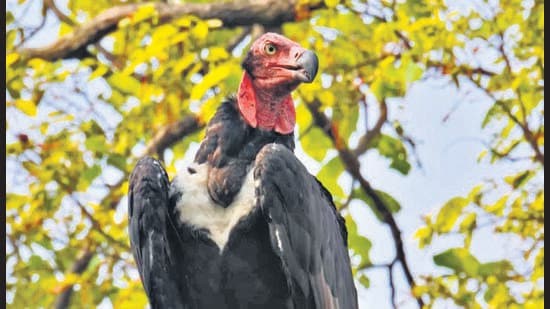Description

Disclaimer: Copyright infringement not intended.
Context: Red-headed vulture seen at Delhi’s Bhatti mines, first since 2017. The bird was spotted during an ongoing winter raptor survey, which is carried out by the Bombay Natural History Society each year at the Asola Bhatti Wildlife Sanctuary
Details:
- The red-headed vulture (Sarcogyps calvus) belongs to the family Accipitridae.
- These red-headed vulture species are distributed in Southeast Asia and Indian Subcontinent.
Taxonomy of Red-headed vulture:
- Scientific Name: Sarcogyps calvus
- Common Name: Red-headed vulture
- Other names: Vultur calvus Scopoli, 1786; Asian king vulture; Indian black vulture; Pondicherry vulture;
- Family: Accipitridae › Accipitriformes › Aves › Chordata › Animalia
- Sarcogyps calvus was earlier included in genus Vultur.
Description:
- The red-headed vulture is a large bird, measuring 75 to 85 cm in length and weighing 3,500 to 5,500 grams. The wingspan is 200 to 230 cm.
- It is mainly black except for bare reddish head, neck and legs. It has a pale grey band at the base of the flight feathers. The male bird has a paler, whitish iris, while the female has dark brown iris.
.jpeg)
Habitat:
The red-headed vulture prefers open country usually away from human habitation, well-wooded hills and dry deciduous forest with rivers.
Distribution:
These red headed vulture species are distributed in India, Nepal, Bangladesh and Bhutan in Indian Subcontinent. Small populations are present in Myanmar, Laos and Cambodia. It was previously present in South China, Thailand, Vietnam, Malaysia and Singapore.
Status and conservation:
- The red-headed vulture global population is estimated to number 3,500 to 15,000 individual birds.
- The Indian vulture population declined by 90% mainly due to toxicity from diclofenac present in carcasses of cattle. The drastic reduction in the wild ungulate population, reduced availability of feed and increased human activity in the habitat are the threats for their survival.
- The IUCN (International Union for Conservation of Nature) has categorized and evaluated these bird species and has listed them as "Critically Endangered".

https://www.hindustantimes.com/cities/delhi-news/redheaded-vulture-seen-at-delhi-s-bhatti-mines-first-since-2017-101675017171407.html












